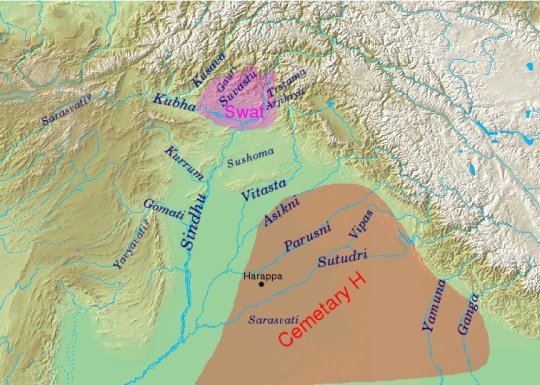#Saptasindhav
Text
1. The land of Saptasindhavah (सप्तसिन्धवः)
Since the dawn of civilization, the mighty Himalayas have always protected the people living in Indian sub-continent, not only from natural phenomena like sandstorms originating on central Asia plains or blistering arctic cold winds or great floodwaters sweeping the north Indian plains, that could have created existential problems for the early settlers. The unscalable peaks and ranges of world’s tallest mountain also prevented the barbaric wild Asian steppe hordes, attacking and destroying the inhabitations, including cities and towns of subcontinent, the way they did in China and east Europe.
Yet, in spite of this guardian angel, protecting our borders, wild hordes of invaders and intruders, cruel and murderous tribesmen, monarchs, brave warriors with monarchy aspirations and people who themselves were pushed out from their country, found routes that circumambulated the vast mountain ranges and enter the sub-continent over last two millennia. These intruders and their barbaric armies, created a profound impact on the culture of the sub-continent that had evolved over last five or more millennia, starting from Sindhu-Sarswati Civilization, the Vedic era, Buddhist ideas and finally the Sanatan Dharma. Some of the early intruders adopted to native religions, but some imposed their own religious doctrines, creating a great divisive force that continues to torment the sub-continent, even today.
It so happens that the most profound impact of the intruders took place in a geographical area of the subcontinent, where Sindhu-Sarswati civilization once flourished five or more millennia ago. This land could be rightly called as the heart or core of the sub-continent culture. This region, in the northwest corner of the sub-continent, is none other than the land of seven rivers or Saptasindhavah (सप्तसिन्धवः) of the Vedas.
In the oldest Veda or Rigveda, the sage Angirasa, while offering oblation to Sun God ‘Savita” describes him as,
अ॒ष्टौ व्य॑ख्यत्क॒कुभः॑ पृथि॒व्यास्त्री धन्व॒ योज॑ना स॒प्त सिन्धू॑न् । हि॒र॒ण्या॒क्षः स॑वि॒ता दे॒व आगा॒द्दध॒द्रत्ना॑ दा॒शुषे॒ वार्या॑णि ॥ (1.35.8)
“He has lighted up the eight points of the horizon, the three regions of living beings, the seven rivers; may the golden-eyes Savitā come hither, bestowing upon the offerer of the oblation desirable riches.”
The next question that naturally arises is the names of rivers that constitute this land of seven rivers. Luckily Rigveda helps us even here. The Nadistuti sukta (नदिस्तुति सूक्त), or “the hymn in praise of rivers”, gives us names of these seven rivers for the reconstruction of the geography of this area.
The first and foremost river that this Sukta (10.75.1) mentions is obviously Sindhu or The Indus, the mightiest of them all. Other rivers that are mentioned (10.75.5) in east to west direction are Sarasvati, Shutudri (Sutlej), Parushni (Iravati, Ravi), Asikni (Chenab) and finally Vitasta (Jhelum). This defines the land of seven rivers as the region that begins with Sarswati in the east, but does not end with Indus in the west.
The next verse (10.75.6) describes the tributaries like Kubha (Kabul River), Gomati (Gomal) and Krumu (Kurram),that merge with Sindhu in the plains. Using this information, we can create a map of the landmass, which Rigveda describes as ‘Saptasindhav’. We must also include here the plains, west of Indus River that stretch to the mountains and also the Basin of no longer visible Sarswati River, now found only through archaeological and satellite data. However, we shall not indulge in that endeavor as it is unrelated to our subject matter. Figure 1.1 shows the exact locations of these rivers except River Sarswati.
By Dbach...

View On WordPress
0 notes